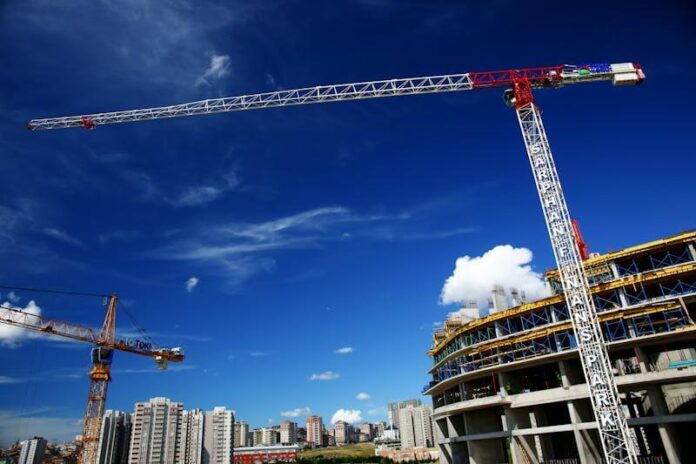Construction sites are always busy areas where various activities occur in the same location. With so many people, large machinery, and valuable materials at work, safety and security must be prioritised first. Robust safety measures not only protect workers but also improve project management overall.
A comprehensive approach to safety involves a combination of training, equipment, and monitoring systems. This article explores how these factors complement one another to create a healthier and more efficient construction environment.
Worker Safety Training and Protocols
Practical worker training is an essential part of the safety program at any construction site. Training programs should cover:
- Hazard Identification: Workers should be able to recognise potential hazards on site, such as exposed electrical wires or unstable scaffolding.
- Proper Equipment Use: Correct use of machinery and tools is essential to prevent accidents.
- Emergency Procedures: Knowing how to respond to emergencies, including first aid and evacuation protocols, saves lives.
Regular refresher courses ensure that worker safety knowledge stays current, reinforcing best practices and adapting to new challenges.
Leveraging Technology for Safety
Modern technology is critical to enhancing safety on construction sites. Innovative tools and systems provide real-time data and insights, helping reduce risks and enabling swift responses.
Wearable Safety Devices
Wearable technology has become essential to advancing workplace safety by constantly monitoring workers’ vital signs and environmental conditions as they work in real-time.
Such devices can spot early warning signals for health dangers, such as heat stress or exposure to toxic gases, and send information straight to supervisors on duty, whether in town or away. This proactive approach helps prevent accidents, ensure safer working conditions, and promote good health among workers.
Drone Surveillance
Drones provide real-time data collection and full-scale monitoring of construction sites. They are akin to overhead birds that swiftly identify safety risks and track and ensure conformity with the project’s safety procedures.
Drones eliminate the need for workers to visit such unsafe areas, improving safety at the job site, lowering accidents, and making construction supervision more efficient in general. Ultimately, everyone gets to work and leaves efficiently without an accident.
Efficient Resource Management
Effective resource management, including labour, materials, and equipment, boosts safety, efficiency, and productivity. Proper planning and real-time tracking reduce waste and delays and create a consistent, well-regulated work routine.
Inventory Tracking Systems
High-precision inventory systems carefully track materials from when they arrive until they are used on-site, ensuring optimum resource availability. This system prevents work stoppages by guaranteeing materials are on hand when needed, minimises time lost due to such stoppages, and keeps projects moving according to schedule.
Additionally, it helps avoid hoarding, which would create hazardous, cluttered working environments, and as a result, keeps the construction site both safer and more organised.
Equipment Maintenance
Staying on top of regularly maintaining machinery and equipment is essential for preventing breakdowns and accidents on construction sites. Utilising predictive maintenance tools enhances this process by providing a forecast of potential equipment breakdowns before they happen.
This proactive approach means that repairs can be made quickly, preventing sudden breakdowns and guaranteeing safe, continuous operation. Predictive maintenance also helps extend the service life of machinery and increase project efficiency by addressing issues before they become problems as far as possible.
Role of Security in Construction
While preserving life is the primary goal of safety and preventing accidents, construction site security protects assets from theft. It keeps out people who should not be at a particular construction site.
Implementing strong security measures to protect valuable equipment and materials is important. Surveillance cameras, gate control systems, and on-site guards are all part of construction site security equipment in one way or another. These measures help deter theft, vandalism, and unauthorised access, which improves overall efficiency.
Streamlining Communication
Good communication in the construction industry is vital to safety and efficiency. Regular and comfortable communication with all on-site employees ensures that everyone understands the rules and safety protocols, regardless of their role.
Digital Communication Tools
Digital tools such as project management software and mobile apps enable construction teams to communicate with one another. These platforms allow documents and updates to be shared in real time, not just among a team but throughout the project.
Whatever changes may be made on a job site, all team members can be quickly informed. By improving communication and making it immediately accessible, these tools increase efficiency, reduce human errors, and ensure that all tasks run on time, wherever the team members are.
Daily Safety Briefings
Daily safety briefings are essential for enforcing safety procedures and updating workers about possible dangers. Workers can also raise issues during these meetings and suggest improvements. Open communication in these daily safety briefings means that the right protocols prevail on-site, and no one is unprotected.
Such communication helps to prevent accidents, raise awareness of risks, and, in general, hold up the shield of moderation so that workers don’t fall into carelessness.
The Benefits of a Holistic Approach to Safety and Efficiency
Practising a holistic approach to safety and efficiency has the following advantages for construction projects:
- Reduced Accidents and Injuries: More comprehensive overall precautions reduce the likelihood of accidents so workers are protected and job progress is not held back.
- Enhanced Productivity: Efficient resource use and effective communication make the whole project proceed more smoothly and complete on schedule.
- Cost Savings: Preventing accidents and minor waste can save significant money against the project’s budget.
- Improved Reputation: Showing safety and efficiency can only help a construction enterprise, as it attracts clients and talented artisans worldwide.
Conclusion
We can integrate cutting-edge technology, rigorous worker training courses, and superior safety measures to ensure a project achieves high safety and efficiency. This well-rounded strategy guarantees the security of workers and assets, continuous operation, on-schedule project completion, and overall success.
